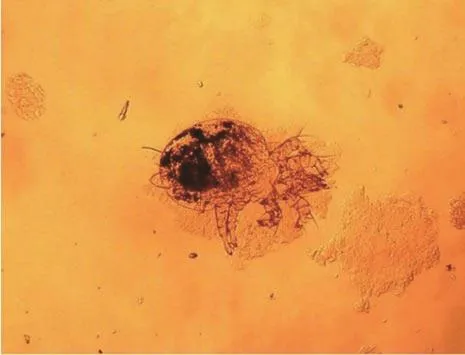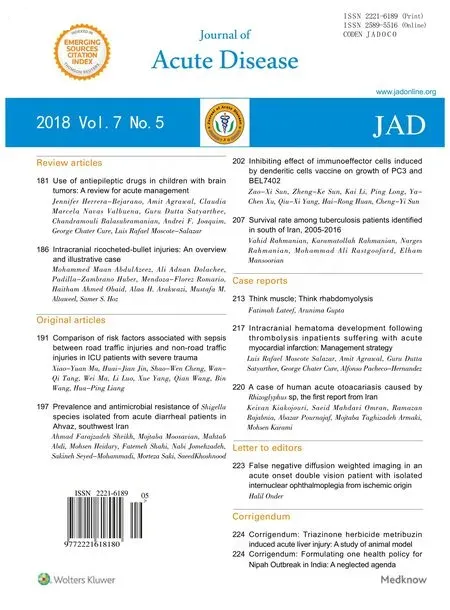A case of human acute otoacariasis caused by Rhizoglyphus sp, the first report from Iran
Keivan Kiakojouri, Saeid Mahdavi Omran, Ramazan Rajabnia, Abazar Pournajaf, Mojtaba Taghizadeh Armaki, Mohsen Karami?
1Department of Ear, Nose, and Throat, Faculty of Medicine, Rohani Hospital, Babol University of Medical Science, Babol, Iran
2Infectious Diseases and Tropical Medicine Research Center, Health Research Center, Department of Parasitology and Mycology, School of Medicine, Babol University of Medical Sciences, Babol, Iran
3Department of Microbiology, Faculty of Medicine, Babol University of Medical Sciences, Babol, Iran
Keywords:Human otoacariasis Rhizoglyphus Auditory canal Mites Iran
ABSTRACT Otoacariasis is the presence of ticks and mites in the auditory canal. A 50-year-old Iranian man was subjected at the an ear, nose, and throat clinic at Rouhani Hospital in Babol with complaint of left ear pain. Otoscopic examination showed mite infestation in the left auditory canal. The infestation was eradicated with the 2% H2O2 solution. Treatment began by applying oral ciprofloxacin (500 mg/day) twice daily for 7 d. We report the rare case of an ear canal infestation with the Rhizoglyphus and their eradication with 2% H2O2 solution.
1. Introduction
Some arthropods, such as ticks and mites, have been known as vertebrate ectoparasites including mammals and birds[1,2], which some of them are fed by sucking human and animal blood. As well as, arthropods act as vectors for several pathogens such as, viruses,bacteria, rickettsial and fungi[2,3]. Furthermore, ticks and mites can be attached within the ear canal which is called the otoacariasis,a common phenomenon in livestock and domestic animals, but rarely in human[2,4]. Ticks and mites commonly attached to the bony part, tympanic membrane and cartilage part of the auditory canal[5-7]. The most common symptoms of otoacariasis are itching,otalgia, foreign body sensation, ear pain and facial palsy[8-10].Some other symptoms include bleeding[11], tinnitus[6], vertigo,hearing loss, vomiting and acute labyrinthitis[12]. There are several reports of human otoacariasis from Saudi Arabia (Loxanoetus)[4],South Africa and United States (Otobius)[13,14], Nepal (Dermacentor)[9], Malaysia (Dermacentor and Haemaphysalis)[5,10] and Sri Lanka(Amblyomma, Boophilus, Hyalomma, Dermacentor, Rhipicephalus and Haemaphysalis)[15,16]. Mites in the genus Rhizoglyphus (Acari:Acaridae) are one of the most important acarine in the family Acaridae. Some species of Rhizoglyphus attack bulbs, roots, corms,plants with bulbs, stored products and many other plants. The maites are commonly known as bulb mite[17-20]. People who handle the mite-contaminated materials could be infested. We describe a case of human acute otoacariasis caused by a bulb mite (Acari: Acaridae:Rhizoglyphus sp). To our knowledge, this is the first report of human otoacariasis caused by Rhizoglyphus in the auditory canal of humans in Iran.
2. Case report
In July 2017, a 50-year-old Iranian man who was living in the Mazandaran, north of Iran, referred to the ear, nose, and throat clinic of the Ayatollah Rouhani Hospital in Babol with complaint of left ear pain for 2 months. He suffered from tinnitus, vertigo, hearing loss,otalgia and otorrhea. The case had worked as a simple worker. He had a history of contact with domestic animals and stored products prior to clinical presentation. There was no other significant clinical history. On otoscopic examination, we observed external auditory canal swelling and mild-obstruction, ear canal inflammation, live and mobile animate foreign bodies. Further examination revealed presence of a dark fluid on the tympanic membrane, ear canal and crawling mites. The patient’s left ear was washed with saline and samples were sent to the Department of Parasitology and Mycology,Babol University of Medical Sciences to entomological survey. Then mites were mounted and were identified at the genus level using valid mites identification keys[18-20]. All mites were identified as Rhizoglyphus sp, based on morphological characteristics (Figure 1).After washing external auditory canal using a solution of H2O2(2%),treatment began by applying oral ciprofloxacin (1 000 mg/day) for 7 d. Ciprofloxacin ear drop (three time in day) and gelofen capsules(one time in day) were also administered to this patient three times each day for 7 d. After 7 d, the complications were reduced. Our patient did not demonstrate any signs of infestation at the end of the fourteenth days. Otoscopic examination also showed complete eradication of the mites in the auditory canal.

Figure 1. Microscopic view of Rhizoglyphus sp, adult mite removed from the left ear of the patient (original).
3. Discussion
Our patient had a history of contact with domestic animals and handle of stored products and vegetative materials. Regarding to the biology of the bulb mite and patient job, trans-infection may have occurred during exposure to these materials. The existence of the live and pregnant female mite, as well as lack of contact with foods and stored products in last month, suggest that the mait can survive and reproduce with feeding on keratinous substances and fragments of the skin inside to the auditory canal. To our knowledge, this is a first report of otoacariasis caused by Rhizoglyphus in Iran, and data on the clinical complications of infestation by this mite in the human auditory canal is negligible, but inconsistent with the other studies, symptoms in above mentioned patient, such as itching,pain, swelling, tinnitus and hearing reduction was present.
Abi-Akl et al. (2017) reported signs such as itching and tinnitus due to the presence of Chortoglyphidae[4]. Indudharan et al. (1996)declared facial palsy, pain and hemorrhagic bulla in a 65-year-old woman whose right ear was infected with Dermacentor tick[10].These complications could be due to the neurotoxins secreted by the tick in the host body. Although exclusive treatments have not been reported, but, the previous studies mentioned the eradication of mite is the first therapeutic action. There are several methods for this aim, such as, mite removal with alligator forceps[21] and gentle washing with warm saline[5]. In the present work, for cleaning the external ear canal, we used from hydrogen peroxide (H2O2, 2%)under otoscopic examination. An oral ciprofloxacin (1 000mg/day),drop ciprofloxacin (3 mg/mL) and gelofen capsules (400 mg), were used for the treatment of bacterial infections, ear chondrite and ear pain reduce, respectively.
We report the patient of a 50-year-old man who presented with left ear pain for two months. Further otoscopic examination showed infestation of mites. The mites were bulb mites or the Rhizoglyphus genus and were successfully eradicated with 2% H2O2solution. It seems, H2O2solution have worked effectively in the eradication of mites in our case, and suggests that its usage may be beneficial in the treatment of otoacariasis.
Conflict of interest statement
The authors declare that they have no conflict of interest.
 Journal of Acute Disease2018年5期
Journal of Acute Disease2018年5期
- Journal of Acute Disease的其它文章
- CORRIGENDUM
- False negative diffusion weighted imaging in an acute onset double vision patient with isolated internuclear ophthalmoplegia from ischemic origin
- Intracranial hematoma development following thrombolysis inpatients suffering with acute myocardial infarction: Management strategy
- Think muscle; Think rhabdomyolysis
- Survival rate among tuberculosis patients identified in south of Iran,2005-2016
- Inhibiting effect of immunoeffector cells induced by denderitic cells vaccine on growth of PC3 and BEL7402
